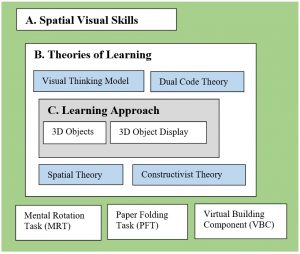Holographic Technology for Improving Students’ Spatial Visualization Skills
– Headed by Assoc. Prof. Dr. Azlina Ahmad.
Visualization skill is important in problem solving process in the fields of science, technology, engineering and mathematics (STEM). However, from our initial analysis, we observed that most students with low achievement in STEM related subjects have poor visualisation skills. Therefore, the purpose of this research is to help students improve their visualisation skills using holographic technology.
INTRODUCTION OF RESEARCH
Many students are facing problems with STEM related subjects in schools. From our three (3) Initial Analysis studies conducted on primary school students in Malaysia, we found that students who are below-average in STEM related subjects are also having problems in spatial visualisation skills. Therefore, this study aims to help students improve visualization skills of students through training of spatial visual skills (SVS), which consists of mental rotation task (MRT) of 3D objects, paper folding task (PFT) to form 3D objects and virtual building components (VBC) to transform 3D objects. This training is difficult for students unless a 3D object resembling a real object is used. Holographic technology is the latest technology that is capable of displaying a realistic representation of 3D objects. Therefore, this research involves the development of a SVS training application using pyramid hologram suitable for use in schools. By relating the observations made during preliminary studies to learning theories, the 3D SVS training model is formulated. The model is shown in figure below. The 3D SVS training model is formulated for the purpose of training 3D spatial visual skills among learners and to improve their cognitive processes during visualization.
The development of application using hologram pyramid based on 3D SVS training model involves design of hardware and software components. Hardware components comprise of a pyramid-shaped acrylic glass and a display monitor. The hologram pyramid is the image reflection component while the display monitor is the image generation component. The following table shows the hardware requirements needed for the development of 3D SVS training application.
The structure design of our hologram pyramid is displayed in the figure below
FINDINGS OF RESEARCH
Evaluation of SVS training application was conducted involving students at a school in Selangor. Several evaluation instruments were developed and tested for its validity such as questionnaires, and pre-test and post-test questions. The study found that the performance of students in the post-test was higher than the performance of students in pre-test for the effectiveness construct. The results shows that after using the SVS training application students SVS skills have significantly improved. Students found that learning visualization skills with SVS training application using hologram pyramid was simple and easy to understand. Almost all the students involved in the study, can perform assigned tasks without the help from teachers, researchers or friends. Among the contributions of this study are: (i) Development Model of KSV Application using Floating Image Hologram Pyramid; (ii) training modules of KSV application using Floating Image Hologram Pyramid; (iii) reflection and generation image display (iv) usability testing instruments of KSV training application.




